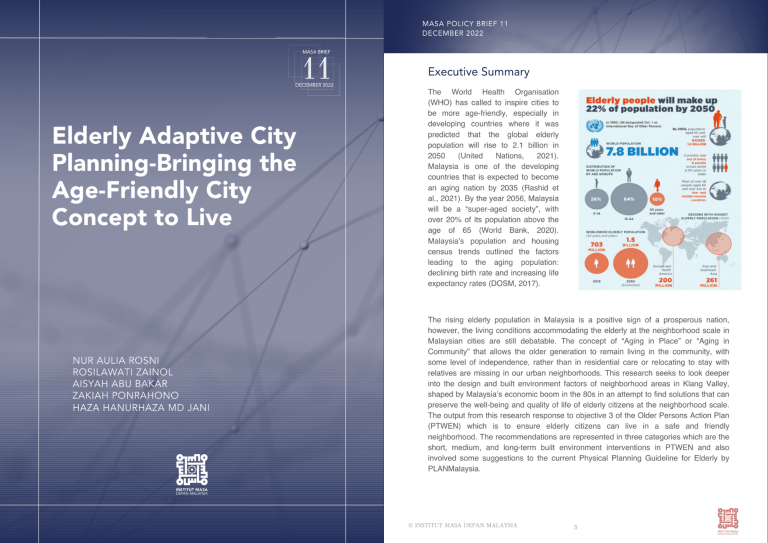The World Health Organisation (WHO) has called to inspire cities to be more age-friendly, especially in developing countries where it was predicted that the global elderly population will rise to 2.1 billion in 2050 (United Nations, 2021). Malaysia is one of the developing countries that is expected to become an aging nation by 2035 (Rashid et al., 2021). By the year 2056, Malaysia will be a “super-aged society”, with over 20% of its population above the age of 65 (World Bank, 2020). Malaysia’s population and housing census trends outlined the factors leading to the aging population: declining birth rate and increasing life expectancy rates (DOSM, 2017). The rising elderly population in Malaysia is a positive sign of a prosperous nation, however, the living conditions accommodating the elderly at the neighborhood scale in Malaysian cities are still debatable. The concept of “Aging in Place” or “Aging in Community” that allows the older generation to remain living in the community, with some level of independence, rather than in residential care or relocating to stay with relatives are missing in our urban neighborhoods. This research seeks to look deeper into the design and built environment factors of neighborhood areas in Klang Valley, shaped by Malaysia’s economic boom in the 80s in an attempt to find solutions that can preserve the well-being and quality of life of elderly citizens at the neighborhood scale. The output from this research response to objective 3 of the Older Persons Action Plan (PTWEN) which is to ensure elderly citizens can live in a safe and friendly neighborhood. The recommendations are represented in three categories which are the short, medium, and long-term built environment interventions in PTWEN and also involved some suggestions to the current Physical Planning Guideline for Elderly by PLANMalaysia.
#11 : Elderly Adaptive City Planning-Bringing the Age-Friendly City Concept to Live
- Laporan Dasar, Program Pembangunan Dasar MASA
Kongsi Artikel
Artikel Lain
Artikel
Oleh Mohamad Fauzi Ahmad Meskipun ekonomi Malaysia bergantung pada permintaan domestik, sumbangan bumiputera...
Siaran Media
KENYATAAN MEDIA 16 PENYELIDIK TERPILIH MENERIMA GERAN PENYELIDIKAN MASA 1 OGOS 2025 KUALA...
Siaran Media
KENYATAAN MEDIA TINJAUAN KAJI SELIDIK PENDAPAT UMUM MENGENAI PRESTASI PENTADBIRAN, SOSIO-EKONOMI DAN POLITIK...
Artikel
Oleh Solahuddiin Ismail Mina Jangka hayat ketika lahir adalah satu anggaran purata umur...
Artikel
Oleh Mohamad Fauzi Ahmad Meskipun ekonomi Malaysia bergantung pada permintaan domestik, sumbangan bumiputera...
Siaran Media
KENYATAAN MEDIA 16 PENYELIDIK TERPILIH MENERIMA GERAN PENYELIDIKAN MASA 1 OGOS 2025 KUALA...
Siaran Media
KENYATAAN MEDIA TINJAUAN KAJI SELIDIK PENDAPAT UMUM MENGENAI PRESTASI PENTADBIRAN, SOSIO-EKONOMI DAN POLITIK...
Artikel
Oleh Solahuddiin Ismail Mina Jangka hayat ketika lahir adalah satu anggaran purata umur...
Artikel
Oleh Mohamad Fauzi Ahmad Meskipun ekonomi Malaysia bergantung pada permintaan domestik, sumbangan bumiputera...




